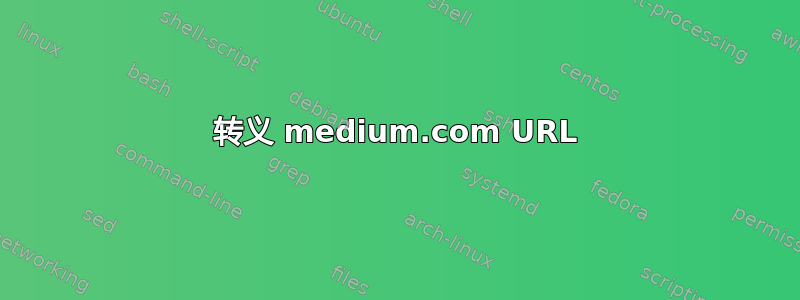
modernCV 中的以下 URL -
\cventry{2016}{志愿组织者}{Reversim Summit 2016}{以色列}{}{组织了 \small \textcolor{cyan}{\href{https://medium.com/@rantav/reversim-summit-2016-by-the-numbers-32046c36c9e#.a9fng7yyj{以色列最大的社区会议}},协调一支由 25 名志愿者、53 名演讲者和 925 名独立访客组成的团队。}
给我带来了这个麻烦:
! Illegal parameter number in definition of \Hy@tempa.
<to be read again>
.
l.77 ...eers, 53 spakers and 925 unique visitors.}
我尝试使用 来逃避&,\&但是没有成功。
使用缩短的链接效果很好:
\cventry{2016}{志愿组织者}{Reversim Summit 2016}{以色列}{}{组织了 \small \textcolor{cyan}{\href{SHORTENED-LINK-I-CAN-NOT-PASTE-IN-THIS-SITE}{以色列最大的社区会议之一}},协调了一支由 25 名志愿者、53 名演讲者和 925 名独立访客组成的团队。}
知道如何https://medium.com/@rantav/reversim-summit-2016-by-the-numbers-32046c36c9e#.a9fng7yyj在现代 Cv 技术中逃脱吗?
答案1
您的 URL 的问题在于#其中使用的字母。
我知道的唯一方法是定义一个强大的 url(参见包的文档url,第 2 章“定义一个定义的 url”):。\urldef{\myself}\url{myself%[email protected]}
对于你的情况你可以使用
\urldef{\med1}\url{https://medium.com/@rantav/reversim-summit-2016-by-the-numbers-32046c36c9e#.a9fng7yyj}
或者用%40代替@(URL 编码):
\urldef{\medium}\url{https://medium.com/%40rantav/reversim-summit-2016-by-the-numbers-32046c36c9e#.a9fng7yyj}
要在代码中调用 URL,您只需使用命令\med1或\medium。
@Heiko-Oberdiek 在他的回答中提到, 可以\#代替#。hyperref请参阅他的回答中的解释。以下\url命令也是可能的(请参阅\#):
\url{https://medium.com/@rantav/reversim-summit-2016-by-the-numbers-32046c36c9e\#.a9fng7yyj}
以下 MWE
\RequirePackage[hyphens]{url}
\documentclass[11pt,a4paper,sans]{moderncv}
\moderncvstyle{classic} % casual, classic, banking, oldstyle and fancy
\moderncvcolor{blue}
\usepackage[utf8]{inputenc}
\usepackage[scale=0.75]{geometry}
% personal data
\name{John}{Doe}
\title{Resumé title}
\address{street and number}{postcode city}{country}
\phone[mobile]{+1~(234)~567~890}
\phone[fixed]{+2~(345)~678~901}
\phone[fax]{+3~(456)~789~012}
\email{[email protected]}
\homepage{www.johndoe.com}
\social[linkedin]{john.doe}
\social[twitter]{jdoe}
\social[github]{jdoe}
\extrainfo{additional information}
\photo[64pt][0.4pt]{example-image-a}
\quote{Some quote}
\setlength{\footskip}{66pt}
\urldef{\medium}\url{https://medium.com/%40rantav/reversim-summit-2016-by-the-numbers-32046c36c9e#.a9fng7yyj}
\urldef{\med1}\url{https://medium.com/@rantav/reversim-summit-2016-by-the-numbers-32046c36c9e#.a9fng7yyj}
\begin{document}
\makecvtitle
\cventry{2016}{Volunteering organizer}{Reversim Summit 2016}{Israel}{}{%
Organized one of the \small \textcolor{cyan}{\medium} largest community
conferences in Israel, coording a team of 25 volunteers, 53 spakers
and 925 unique visitors.}
\cventry{2016}{Volunteering organizer}{Reversim Summit 2016}{Israel}{}{%
Organized one of the \small \textcolor{cyan}{\med1} largest community
conferences in Israel, coording a team of 25 volunteers, 53 spakers and
925 unique visitors.}
\cventry{2016}{Volunteering organizer}{Reversim Summit 2016}{Israel}{}{%
Organized one of the \small \textcolor{cyan}{%
\url{https://medium.com/@rantav/reversim-summit-2016-by-the-numbers-32046c36c9e\#.a9fng7yyj}}
largest community conferences in Israel, coording a team of 25 volunteers,
53 spakers and 925 unique visitors.}
\end{document}
显示两种可能性并给出以下结果:
答案2
问题是#。它用于 TeX 宏定义的参数。通常,\href会将类别代码更改为允许#在其第一个参数中。但在这里,\href用于其他宏的参数(\textcolor,\cventry)中,并且类别更改来得太晚,因为 的参数\href已被标记化。
出于这个原因,\href也支持使用\#而不是#:
\href{https://example.com/foobar\#anchor}{...}



